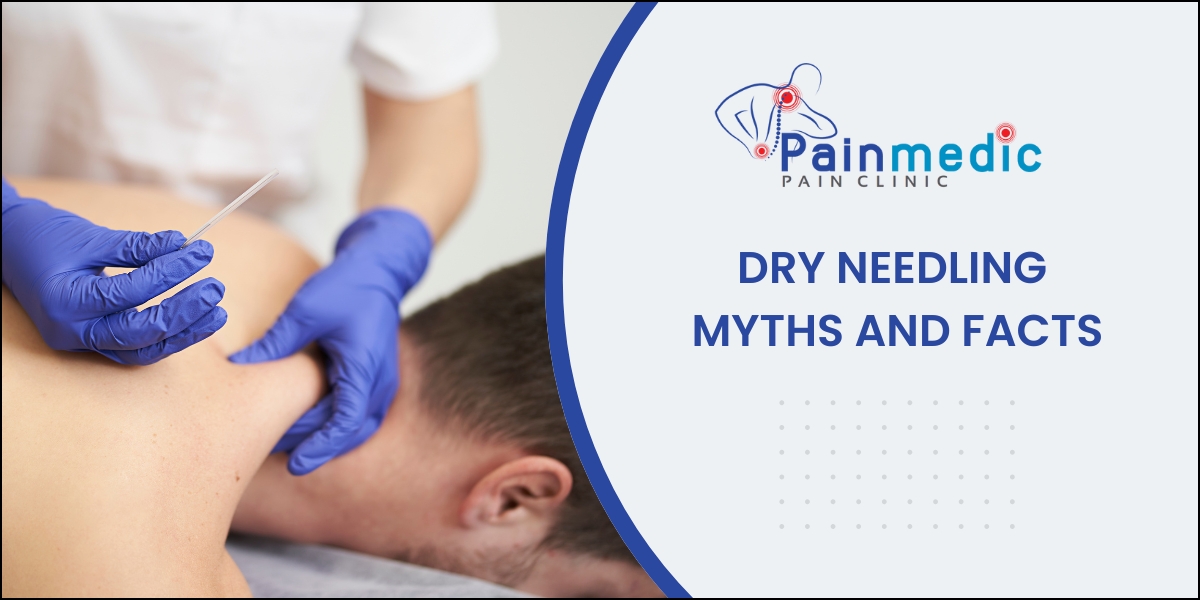
Dry Needling : Myths and Facts
If you’re struggling with persistent muscle pain, stiffness, or limited mobility, you may have heard of a treatment called dry needling. As a leading provider of dry needling therapy in Pune, the team at Painmedic Pain Clinic often encounters questions and misconceptions about this powerful technique. Is it the same as acupuncture? Does it hurt? Let’s separate the common myths from the evidence-based facts.
Myth 1: Dry Needling is the Same as Acupuncture.
Fact: While both use thin, filiform needles, their foundations and goals are entirely different. Acupuncture is a key component of Traditional Chinese Medicine, focusing on balancing the body’s energy flow (Qi) along meridians. Dry needling, on the other hand, is grounded in modern Western medicine and anatomy. It specifically targets myofascial trigger points—those tight, painful knots in your muscles that cause pain and restrict movement. The goal is to deactivate these trigger points, reduce pain, and improve function.
Myth 2: Dry Needling is Extremely Painful.
Fact: The insertion of the needle is typically not painful due to its fineness. The intended therapeutic sensation is a brief, deep ache or a local twitch response in the muscle. This twitch is a positive sign, indicating the targeted muscle band is releasing. While this can be momentarily uncomfortable, most patients describe it as a “good hurt” that leads to significant relief afterward. Any mild soreness usually subsides within 24 hours.
Myth 3: It’s Only for Athletes with Sports Injuries.
Fact: While athletes certainly benefit from dry needling for pain and faster recovery, it is not exclusive to them. This therapy is highly effective for a wide range of musculoskeletal conditions experienced by the general public. This includes neck and back pain, tension headaches, migraines, jaw pain (TMJ), shoulder impingement, tennis elbow, and plantar fasciitis. If your pain originates from tight muscles, dry needling can likely help.
Myth 4: The Needles Inject Medication.
Fact: This is a common source of confusion! The “dry” in dry needling explicitly means that no substance is injected into the body. The procedure uses solid, single-use, sterile needles to mechanically stimulate the trigger point. This contrasts with “wet” needling, where substances like corticosteroids or analgesics are injected. The therapeutic effect comes purely from the needle itself.
Myth 5: Any Practitioner Can Perform Dry Needling.
Fact: This is a critical point. Effective and safe dry needling requires extensive training in human anatomy, neuromuscular systems, and needling techniques. At Painmedic Pain Clinic, our therapists are certified and highly skilled in performing dry needling in Pune. It is essential to seek treatment from a qualified healthcare professional, such as a physical therapist or a doctor, who has undergone specialized post-graduate training in this technique.
If you are looking for a drug-free, evidence-based solution to your muscle pain, dry needling at Painmedic Pain Clinic could be the answer. Our expert team is dedicated to providing safe and effective pain management in Pune to help you regain a pain-free, active life.
Frequently Asked Questions (FAQs)
1. What is dry needling used for?
Dry needling is used to treat myofascial pain and dysfunction, including muscle knots, trigger points, neck/back pain, headaches, and sports injuries.
2. Is dry needling better than a massage?
They are different. Massage addresses broader muscle tissue, while dry needling precisely targets deep trigger points. They can be complementary therapies.
3. How long does it take for dry needling to work?
Many patients feel immediate relief in mobility and a reduction in pain after the first session, with continued improvement over a course of treatments.
4. What are the side effects of dry needling?
Common, temporary side effects include minor soreness, bruising, or slight bleeding at the needle site. Serious side effects are rare when performed by a trained professional.
5. Who should avoid dry needling?
It is not recommended for individuals with a fear of needles, bleeding disorders, or who are pregnant (on certain areas). A thorough screening is always done first.




